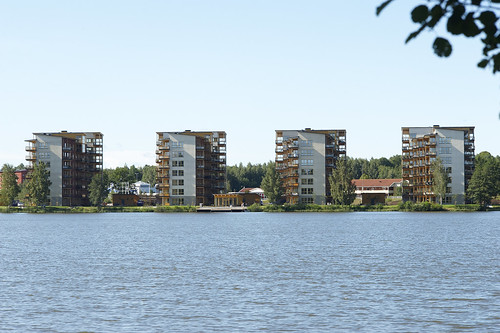
Cross-posted from the White House Rural Council:
As part of the Obama administration's commitment to mitigate climate change, USDA, in partnership with the Softwood Lumber Board and the Binational Softwood Lumber Council, is announcing the U.S. Tall Wood Building Prize Competition. This competitive prize, open to teams of architects, engineers, and developers, will showcase the architectural and commercial viability of advanced wood products like Cross Laminated Timber (CLT) in tall buildings.
Advanced wood products are becoming the latest innovation in tall building construction. Products like CLT are flexible, strong, and fire resistant. In construction, wood products can be used as a successful and sustainable alternative to concrete, masonry, and steel. Using wood also reduces greenhouse gas emissions by storing carbon and simultaneously offsetting emissions from conventional building materials. By some estimates, the near term use of CLT and other emerging wood technologies in buildings 7-15 stories could have the same emissions control affect as taking more than 2 million cars off the road for one year.
Wood can also help struggling rural forest communities. During the Recession, the drop in new construction and decline in home remodeling had a deep impact on wood manufacturing. However, if CLT and similar advanced wood products can penetrate just 5 - 15% of the non-residential North American market, that would mean roughly 0.8 - 2.4 billion board feet of lumber consumed annually. To put that in real-world context, roughly 35 jobs are created for each million board feet of wood processed.
The winner of the Tall Wood Building competition will receive support for incremental costs of pioneering wood construction techniques to address the engineering design and code variances needed to incorporate wood technologies into new building sites. The competition requires that the winning project team source a share of materials from rural, domestic manufacturers and domestic, sustainably managed forests in order to jumpstart new production and economic opportunities in rural America.
The launch of this competition is part of USDA's overall strategy to promote the use of wood as a green building material. In addition, the White House Rural Council hosted the Building With Wood: Jobs and the Environment workshop in March 2014. USDA's Forest Service has also partnered with WoodWorks to provide outreach and technical support for architects and engineers of wood construction, supported a new commercial-scale CLT manufacturing facility in Columbia Falls, Montana, and invested more than $2 million in research and technical support for emerging wood technologies through the Forest Products Laboratory in Madison, Wisconsin.
Wood is a readily available and renewable building material that creates jobs and stimulates the economy. It can be used in urban or rural settings to build energy-efficient houses, buildings, and other needed infrastructure. It is successfully being used around the world and can help mitigate climate change.
As Secretary Vilsack said at the March Workshop, "Wood may be one of the world's oldest building materials, but it is now also one of the most advanced." Additional information about the competition is available at www.tallwoodbuildingcompetition.org. Winners will be announced in 2015.
Doug McKalip is Senior Policy Advisor for Rural Affairs with the White House Domestic Policy Council.
